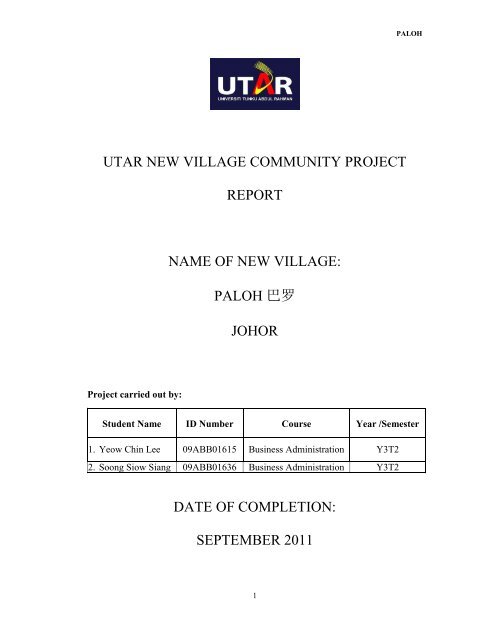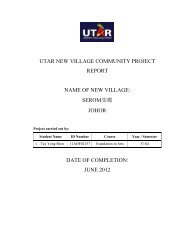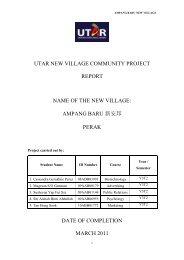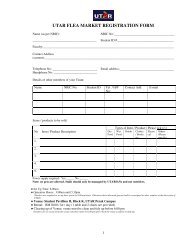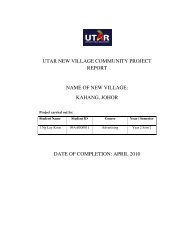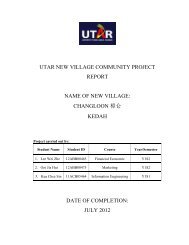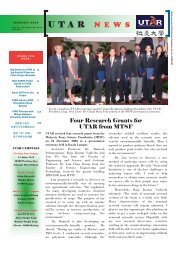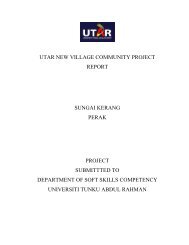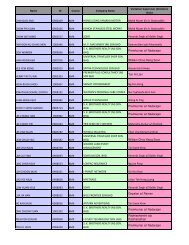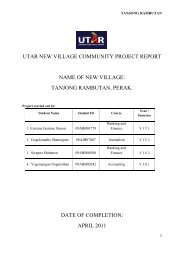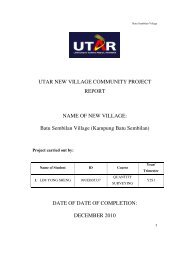UTAR NEW VILLAGE COMMUNITY PROJECT REPORT NAME OF ...
UTAR NEW VILLAGE COMMUNITY PROJECT REPORT NAME OF ...
UTAR NEW VILLAGE COMMUNITY PROJECT REPORT NAME OF ...
Create successful ePaper yourself
Turn your PDF publications into a flip-book with our unique Google optimized e-Paper software.
PALOH<strong>UTAR</strong> <strong>NEW</strong> <strong>VILLAGE</strong> <strong>COMMUNITY</strong> <strong>PROJECT</strong><strong>REPORT</strong><strong>NAME</strong> <strong>OF</strong> <strong>NEW</strong> <strong>VILLAGE</strong>:PALOH 巴 罗JOHORProject carried out by:Student Name ID Number Course Year /Semester1. Yeow Chin Lee 09ABB01615 Business Administration Y3T22. Soong Siow Siang 09ABB01636 Business Administration Y3T2DATE <strong>OF</strong> COMPLETION:SEPTEMBER 20111
PALOHABSTRACTPaloh is a historical village. It is a new village established after 1960. Palohcovers 46,000 hectares of which 40,000 hectares are agricultural land. Oil palm is themain crop in Paloh. There are many areas are oil palm estates. There are severalkindergartens, primary schools, national primary schools, secondary schools andreligious schools here. There are many places of worship in Paloh. Although basicinfrastructures are available, this needs further development.2
PALOHINTRODUCTION AND HISTORYPaloh is a village in the Kluang district of Johor, Malaysia. It is located southwest of Bandar Kluang. According to some, the name Paloh was derived from theChinese word „Payao‟ which means „swamp‟ in Chinese. The name was givenbecause Paloh was covered by swamps before it was developed. The town wasfounded by Ng Lin Mong and a group of overseas Chinese from China in 1916.The scenery of housing & estate in Paloh.According to the headman of the village, the population of Paloh is 16, 240.There are 9,083 males and 7,337 females in Paloh (www.paloh.my). There are 5residential areas which are Taman Sri Kota Paloh, Taman Wijaya, Taman Paloh,Taman Melati, Taman Murni, Kampung Muhibbah. There are about 5,824 houses(www.paloh.my) in Paloh.3
PALOHVisitors can use either the Paloh-Kluang Road or the Paloh-Yong Peng Roadto reach Paloh. Another way to reach Paloh is by train. In the 1950‟s there waslimited access to Paloh. At that time, there was a muddy road from Paloh to Kluangand it took around 1.5 hours to reach Kluang. In the 1980‟s, the Malaysiangovernment built Jalan Paloh. The existing Paloh road between Kluang and Palohwas built in 1999.As they approach Paloh, visitors will pass by a number of oil palm plantations.Paloh covers 46,000 hectares of which 40,000 hectares are agricultural land. Thevillage scenery is green and tranquil.Green: Oil palm trees along the journey4
PALOHDuring the Malayan Emergency (1948-1960), Paloh was a communiststronghold. It was considered a “black area” of communist terrorists andsympathizers.Besides residential homes, the village has a row of shop lots in 1937 and anMCA building. We interviewed 2 shop owners: Mr Sahibjan Z.M.K. and Mr WongChia Fatt.Mr Sahibjan is 85 years old and came from India in 1930. He started hisbusiness in 1937 and sold spices, milk and other groceries in those days. Currently,he sells newspapers. According to him, Central Paloh was basically a rubber estatebefore it was developed.We also interviewed Mr Wong who is 71 years old. He owns the Ling NamCoffee Shop and collects old memorabilia such as stamps, drink bottles and oldtickets. He was very informative on the history of Paloh.74 years old shop5
PALOHLing Nam Coffee ShopMr. Wong’s collection of old memorabilia6
PALOHECONOMIC ACTIVITIESMore than 25,000 hectares of land in Paloh are used for plantations. Oil palmis the main crop in Paloh. Here, the traditional method of transporting the oil palmfruits is used. In some estates, buffaloes are still used to transport the oil palm fruitsto the collection centre. Prior to using buffaloes, estate workers had to carry the ripeoil palm fruits themselves.There are 10 oil palm estates in Paloh such as Bukit Cocok Estate, KempasEstate and Landak Estate. Previously, most of the villagers worked in the oil palmestates but the numbers have dwindled especially among the youth. As more youthsreceive formal education, they prefer working in government departments or theprivate sector in Kluang and Johor Bahru. There are some who work in Singapore.Oil palm estatesApart from working in plantations, some villagers manage fruit orchards(durian and rambutan especially) and plant coconut on a small-scale. As in KampungMelayu Batu Empat, cultivation by clusters is practised.7
PALOHThere are also villagers who operate dragon fruit (pitaya fruit) orchards on alarge scale. For instance, Khalid Baba has been cultivating the dragon fruit for thepast three years and the orchard is next to his goats‟ pen. Initially, the JohorAgriculture Department assisted by providing fertilisers. Now, Encik Khalid uses hisorganic goat fertiliser, which is of high quality. This fertiliser has been sprayed withthe Effective Micro organism (ME) which is a kind of bacteria that is environmentfriendly.A dragon fruit entrepreneur can easily earn at least RM1, 500 per month forevery one hectare of dragon fruit. This calculation is based on the selling price of thefruit which is RM 2.50 per kilograms. However, this income fluctuates in relation tothe price of these fruits in the market, demand, size, quality and weather.Other than that, a number of villagers are self-employed and operate smallscalebusinesses such as sundry shops, food stalls and vegetables and fruit farms.There are also stalls in the local wet market which is located close to the Paloh busstation.Center of Paloh8
PALOHWet market beside bus stationPaloh‟s economy is also supported by a few factories which manufactureclothes and mechanical accessories. These factories hire many foreign workers.Two factories in Paloh9
PALOHEDUCATIONThere are several kindergartens, primary schools, national primary schools,secondary schools and religious schools in Paloh. They meet the differenteducational needs of the population.One of the primary schools here is the Sekolah Kebangsaan (SK) 2 Palohwhich is adjacent to the Sekolah Menengah Kebangsaan (SMK) Paloh. More than300 pupils are enrolled in SK Paloh which has a teaching force of 25 teachers.Meanwhile, about 1,700 students are enrolled in SMK Paloh. There are a number ofschools that provide religious education such as Sekolah Agama Paloh and SekolahAgama Batu Empat.One of the kindergartens in front of train station10
PALOHThe front gate of SK PalohThe front gate of SMK Paloh11
PALOHSOCIAL, CULTURAL AND RELIGIOUS PRACTICEPeople here are very helpful and hospitable. When we told them we weregathering information about Paloh, they were willing to answer our questions. Thereare many old folks in the village while many from younger generation have moved tothe cities in search of better employment opportunities. A food stall operatorinformed us that business picked up on weekends when the younger generationreturned home.There are three Chinese temples, a mosque, a Hindu temple and a church inPaloh. This reflects its multiracial population of Chinese, Malays and Indians.The biggest temple in Paloh is Lin Shan Si ( 灵 山 寺 ). It was built in 1934.Most of the Chinese residents worship in this temple which holds several culturalevents every year.Lin Shin Si: A Buddhist temple12
PALOHA Chinese temple called “Great Sage Equaling Heaven Palace” ( 齐 天 宫 )worships the deity Sūn Wùkōng ( 孙 悟 空 ). Sun WuKong declared himself the "GreatSage Equaling Heaven".Temple of Great Sage Equaling Heaven13
PALOHThe local mosqueA Hindu Temple which is under construction14
PALOHThe local ChurchZhen Kong Jiao temple which was built in 197515
PALOHWhen exploring the town, we found a variety of good food available. Sin YuLee, a restaurant in Paloh is often used for wedding dinners. It is open daily from1.00pm to 11.00pm. Another restaurant which also offers wedding dinners is ShuangHsi.Sin Yu Lee RestaurantShuang Hsi Restaurant16
PALOHINFRASTRUCTUREThere are many aspects of Paloh‟s infrastructure which need governmentsupport for development.Buses and trains are the 2 main modes of public transport. There are busesbetween Paloh and Kluang every hour from 6am to 9pm daily. The train service isconnected to the north-south line. This means that Paloh is connected by rail to as farsouth as Singapore and as far north as Penang.Signboard of Paloh’s KTM station17
PALOHThe Paloh Police Station is located in Pekan Paloh, close to some groceryshops. This police station is responsible for the security of the villagers around Paloh.Police station: The force of policemen and officersThe Voluntary Fire Brigade Force building is located at Jalan Datuk Au. Asthe nearest fire station is located in Kluang, about 30 - 45 minutes drive from Paloh,this voluntary force is relied on to reach the scene of any local fires first.According to Tan Swee Guan, the Voluntary Fire Chief, the police force willinform them of any fire incidents or any emergency cases that require assistance.While waiting for the arrival of the Kluang Fire Station squad, the voluntary membersare responsible for making the first attempt at rescuing the victims. About 20villagers have joined the voluntary fire force and they attend courses and briefingregarding their tasks every week.18
PALOHThe Pertubuhan Ikatan Relawan Rakyat Malaysia (RELA) can also be foundhere. There are several RELA posts which are erected for members to hold theirmeetings. According to Misran Dolah, a Taman Melati RELA member, patrollingPaloh area with the police force is one of the operations involving RELA members.They are also involved in ensuring public safety and controlling traffic wheneverthere are functions or activities which are conducted within the village area.The upper picture shows the RELA office while the lower picture shows VoluntaryFire Force19
PALOHThere is a Klinik Kesihatan Paloh (Clinic Paloh), but it does not have hightechnology equipment and lacks experienced doctors. Patients who are seriouslyinjured or ill will be transported by Clinic Paloh‟s ambulance to the Kluang GeneralHospital. There is a need for a hospital or better equipped clinic to cater to themedical problems of Paloh residents.Klinik Kesihatan Paloh20
PALOHPaloh also has a post office.The local Post Office in PalohThe Telecom Malaysia (TM) tower21
PALOHPROBLEMS AND RECOMMENDATIONFirst, access to medical facilities needs improvement. Klinik Kesihatan Palohlacks a full time doctor. Currently, a doctor is on duty once a week or thereabouts.There are also complaints about the cost of medical services and the attitude of staffat the clinic. Villagers with serious illness have to be transported to Kluang. It isrecommended that the local clinic be staffed with a doctor everyday. In the long term,a local hospital is needed.Second, the population of Paloh is decreasing. Teenagers and young adultsmove out to the towns and cities such as Kluang, Johor Bahru and Singapore. Themain reason for this out-migration is the better employment opportunities in urbanareas. Perhaps more frequent bus service between Paloh and Kluang wouldencourage those working in Kluang to continue residing in Paloh. Ultimately, animprovement in employment and business opportunities in Paloh is needed to stop orreduce this out-migration of local youth.Paloh’s Bus station22
PALOHThe sight of rubbish dumped on vacant land is common in Paloh. This resultsin a stench and an unhealthy environment. Local residents need to be educated onthis manner and to cooperate on clean-up efforts. Perhaps penalties need to beimposed.Rubbish in empty landResidents also complain of cuts in water supply without prior warning. Thisproblem can be overcome if the government gives early warning to resident so thatthey can prepare well when there is no water supply.23
PALOHTOURISM VALUE AND ENTREPRENEURSHIP OPPORTUNITIESPerhaps Paloh‟s old buildings could be used as a tourist attraction because oftheir historical value. About 90 percent of residents of Pekan Paloh are involved inbusinesses, mainly furniture shop, grocery shops and food stalls. Several Malayresidents operate restaurants and food stalls at the premises provided by KluangUtara District Council (MDKU).There are entrepreneurship opportunities. Most of the land in Paloh aresuitable for oil palm trees. The demand for palm oil has increased in recent years dueto its use as a biofuel.Oil palm plantations are a major source of employment. It allows many smalllandholders to participate in the cash economy and also often results in the upgrade ofthe infrastructure within that area.DISCLAIMER:Information contained in this report was compiled by the University‟s students on voluntary basis.Although every effort has been made to check the accuracy of the report, the University accepts noresponsibility whatsoever for any errors or omissions, if any, the University reserves the right to makechanges on the information at any time without prior notice.Should there be any queries regarding contents of the report, please contact:Department of Soft Skills CompetencyTel: 03-78582628 ext 8274, 8656, 8269 (Klang Valley Campus)05- 4688888 ext 2297/2299/2300 (Perak Campus)24


